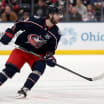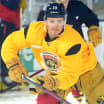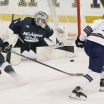As part of the NHL Centennial Celebration, renowned Canadian artist Tony Harris will paint original portraits of each of the 100 Greatest NHL Players presented by Molson Canadian as chosen by a Blue-Ribbon panel. NHL.com will reveal two portraits each Monday in 2017.
This week, the portraits of goaltender Dominik Hasek and defenseman Nicklas Lidstrom are unveiled in the 34th installment.
Hasek, Lidstrom portraits unveiled
Color paintings of 100 Greatest NHL Players will be revealed on NHL.com every Monday in 2017
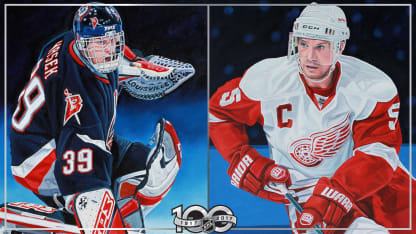
By
NHL.com @NHLdotcom
Few goaltenders stopped the puck so well for so long as Dominik Hasek. None did it with more originality.
Hasek would use any part of his body or equipment to keep the puck out of his net. He would drop his stick and cover a loose puck with his blocker, charge out to stop a shooter on a breakaway and even roll on his back and cartwheel his legs up in the air. Although he improvised like few goaltenders in NHL history, Hasek was able to stay square to the shooter. His movements weren't as random as they seemed, and his work ethic was fierce.
The Chicago Blackhawks selected Hasek, a star in his native Czechoslovakia, in the 10th round (No. 199) in the 1983 NHL Draft. But he didn't come to the NHL until 1990, and when he arrived, he found himself blocked by the emergence of Ed Belfour. The Blackhawks traded him to the Buffalo Sabres on Aug. 7, 1992, and had a breakout season in 1993-94; after starter Grant Fuhr was injured, Hasek were 30-20-6 and led the NHL in goals-against average (1.95) and save percentage (.930). He won the Vezina Trophy for the first of six times in his career.
Three seasons later, Hasek won the Vezina for the third time; this time, however, he also won the Hart and Lester B. Pearson (now the Ted Lindsay) trophies. He won all three again in 1997-98, also claiming the Vezina in 1998-99, when he led the Sabres to the Stanley Cup Final, though they lost to the Dallas Stars in six games.
Hasek won the Vezina for the last time in 2000-01, and helped the Detroit Red Wings win the Cup for the third time in six seasons in 2002-02. He retired from the NHL after the Red Wings won again in 2008, finishing with 389 wins, a 2.20 goals-against average (the lowest of any goaltender to play after 1941) and a .922 save percentage.
In his
NHL100 profile of Hasek
, author Stu Hackel wrote about the long path The Dominator took to stardom:
"He was born Jan. 29, 1965, in the industrial city of Pardubice, a hockey hotbed, and 6-year-old Dominik played his first hockey as a goalie for a 9-year-old team there. The Cold War kept him from seeing NHL goaltenders, and that lack of exposure was one explanation for his individualistic style. Chicago selected him in the 10th round (No. 199) of the NHL Draft in 1983, when getting young Eastern Europeans into the NHL was plainly impossible. By 1990, the combination of Hasek's 10 years of great domestic and international success plus a thawing of East-West relations made his journey across the Atlantic a reality.
"But moving up the Blackhawks depth chart was difficult because of the emergence of Ed Belfour. However, the Sabres had scouted him and, needing a goaltending upgrade, they traded for Hasek two months after his Stanley Cup debut. The Sabres' depth chart was also crowded, but that gave [goalie coach Mitch] Korn time to work with Hasek. 'He was so smart, he knew exactly what was going to happen next, but he was too early,' Korn said. 'So he showed his hand like a bad poker player.'
"The two worked on a more patient approach and improved his use of the catching glove. When No. 1 goalie Grant Fuhr was injured early in the 1993-94 season, Hasek was ready.
"In his first month as a starter, he registered five shutouts. He played 58 games and had a 1.95 average, the first goalie to finish below 2.00 since Bernie Parent was at 1.89 in 1973-74. Though little was expected from the Sabres after top scorer Pat LaFontaine had season-ending knee surgery in early December, Hasek led the Sabres into the postseason against the New Jersey Devils, where Hasek and rookie Martin Brodeur engaged in a terrific matchup, highlighted by a marathon Game 6 that extended into a fourth overtime before the Sabres prevailed 1-0. After six hours and 70 saves, Hasek said he felt he could have played two more periods. The Devils won Game 7, but in June, the 29-year-old Hasek won his first Vezina Trophy, was runner-up for the Hart Trophy and was on his way to superstardom."
Artist Tony Harris said he enjoyed sifting through pictures of Hasek during his preparation.
"It was fun looking through photos of Dominik Hasek's career in preparation for painting his portrait," he said. "Half of the pictures show him making saves from his back using any part of his acrobatic body to make a save. In the end, I felt this pose (perhaps on his way down) worked well, and I loved the intensity in his face."
Defenseman Nicklas Lidstrom's nickname said it all. In Detroit, where he starred for 20 seasons, Lidstrom was known as "The Perfect Human."
There wasn't much that Lidstrom didn't do perfectly, on and off the ice. He won the Norris Trophy as the NHL's top defenseman seven times, more than anyone whose name isn't Bobby Orr, and was the first European-trained player to win the Conn Smythe Trophy as playoff MVP (2002) and captain a Stanley Cup winner (2008).
For good measure, he also scored the winning goal for Sweden in the gold medal game at the 2006 Torino Olympics.
Lidstrom made hockey look easy. He wasn't the fastest skater in the NHL, but he always seemed to be in the right place at the right time. His shot wasn't the hardest, but he seemed to have a knack for getting the puck through traffic to the net. He wasn't terribly physical, but knew how to tie up opponents and give his goaltenders a good look at the puck.
Whatever needed to be done, Lidstrom did it. Perfectly.
In his
NHL100 profile of Lidstrom
, author Stu Hackel wrote that the Swedish star's game was all steak, no sizzle:
"Lidstrom's game was never about flash. You weren't going to see something he did highlighted on play of the day, but he made the plays that paid off at the end of the day.
"Night after night. Game after game. Season after season."
"'He made your game a lot easier,' said Larry Murphy, a Hockey Hall of Famer who was Lidstrom's defense partner with the Red Wings. 'He liked to play the control game and liked to make the play with the puck.'"
Nothing seemed to bother Lidstrom. Even when he committed a rare mistake, his trademark steadiness never wavered.
"'I told this story about him all the time to our young [defensemen]," Maple Leafs coach Mike Babcock remembered from his time behind the Detroit bench from 2005-15. 'If Nick ever made a mistake, like if he passed it to someone in the slot and they shot it in our net, he'd come to the bench, have a drink of water and play the next shift. In other words, nothing bothered him. Just play.
"'He was a just a special, special human being. He was as good a player as he was a person, and a better teammate, a better leader by example and a good family man.
"'In my opinion, he's the best player on the back end of his generation, bar none. Sliding along the blue line, he was as good as I've ever seen. He made you a lot better coach.'"
Harris said he tried to capture some of the things that made Lidstrom so special.
"With more than 1,000 points and seven Norris trophies in his career, I wanted Nicklas Lidstrom's portrait to display his puck-moving and playmaking abilities," he said. "With that in mind I settled on this image, which I also feels shows his steely eyed, cool on-ice demeanor."
Dominik Hasek
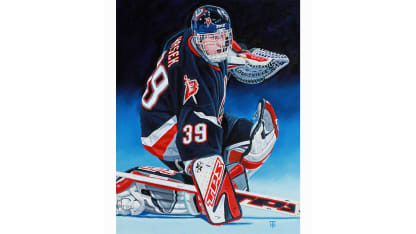
Nicklas Lidstrom








